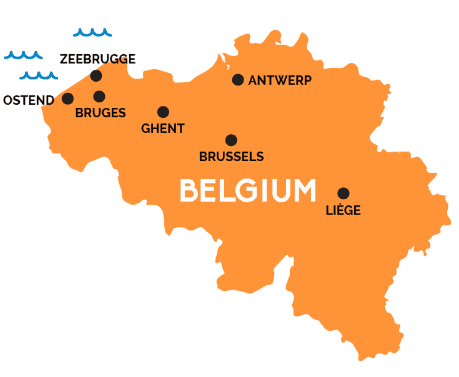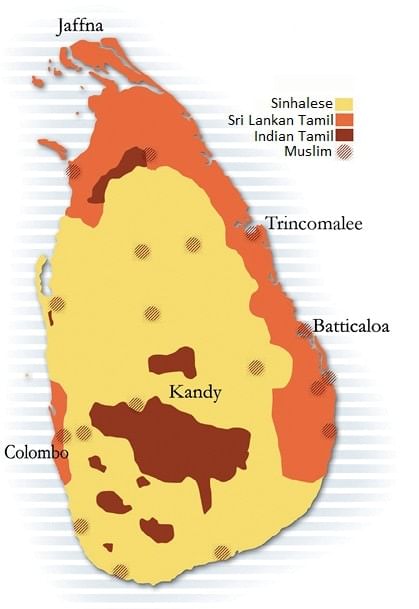Key Concepts: Power-sharing | Social Studies (SST) Class 10 PDF Download
| Table of contents |

|
| Power Sharing |

|
| Forms of Power Sharing |

|
| Story of Belgium |

|
| Story of Sri Lanka |

|
| Majoritarianism in Sri Lanka |

|
| Accommodation in Belgium |

|
| Forms of Power-Sharing |

|
| Frequently Asked Questions |

|
There are two ways of running a government.
- One is a tyranny – In this, the power is concentrated in the hands of a leader or a king.
- On the other hand, the other one is a democracy. In this, the power is delegated at different levels.
The lesson illustrates, with the examples of Belgium and Sri Lanka, how power-sharing is handled by democracies and we learn how necessary it is to share power in a democracy wisely.
Power Sharing
- Power-sharing means the distribution of power among the organs of the government, such as the legislature, executive, and judiciary.
- Power-sharing helps in achieving the stability of political order. In power-sharing, power might even be shared at distinct levels such as union, state and local.
Forms of Power Sharing
In a modern democracy, power-sharing arrangements can take many forms.
Horizontal distribution of power:
In this, the power is shared among different organs of government, such as the legislature, executive, and judiciary. This type of power-sharing is prevalent in India.Federal government (vertical distribution of power):
In this, the power can be shared among governments at different levels. This type of power-sharing is prevalent in the USA.Power-sharing among different social groups:
Power can be shared among social groups, such as linguistic and religious groups. For instance, Community government in Belgium.Other types of power-sharing:
Power sharing is also seen in political parties, pressure groups and movements that control or influence those in power.
Story of Belgium
(i) Geographical Position: A Small country in Europe, bordered by the Netherlands, France and Germany.
 Map of Belgium
Map of Belgium
(ii) Area and Population: Smaller in area than the Indian state of Haryana. The population is a little over one crore, half of the state of Haryana.
(iii) Ethnic Composition: 59% live in the Flemish region - speak Dutch, 40% live in the Wallonia region - speak French, and 1% speak German
(iv) Capital: Brussels; 80% speak French, 20% Speak Dutch.
(v) Important Point:
- In Brussels, the Dutch-speaking people are in a minority, which is the opposite of the rest of the country, where they are in a majority.
 Cheering crowds greet British troops entering Brussels, 4 September 1944
Cheering crowds greet British troops entering Brussels, 4 September 1944
- The minority population of French-speaking people was richer than the Dutch-speaking population.
- The majority community was given benefits much later. This led to tension between the two communities in the 1950s and 1960s. Tension was more acute in the capital city of Brussels.
(vi) Accommodation in Belgium: Belgium constitution was amended four times, between 1970 and 1993, so as to assist all communities to live together within the same country, with the result that it did not suffer from a civil war, demands for autonomy or partition of the country.
Story of Sri Lanka
(i) Geographical Position: A small island in Asia, off the southern coast of Tamil Nadu.
 Ethnic communities of Sri Lanka
Ethnic communities of Sri Lanka
(ii) Population: Same as Haryana’s. About two crore people.
(iii) Ethnic Composition: 74% Sinhalese-speaking people, 18% Tamil-speaking people, 13% are natives of Sri Lanka, known as Sri Lankan Tamils.
The rest are called Tamils, who are descendants of plantation workers who came from India during the colonial period.
(iv) Religion: Most of the Sinhala-speaking people are Buddhists. Most of the Tamils are Hindus or Muslims. Christians constitute 7% of the population, and they belong to both Sinhala and Tamil communities.
Majoritarianism in Sri Lanka
- Majoritarianism: A belief that only the majority community should rule a country, make laws for everyone and with total disregard to the wishes and needs of the minority.
- Sri Lanka became independent in 1948. It immediately adopted measures to impose Sinhala supremacy.
Example:
- It made Sinhalese the official language of the country (by an Act in 1956), and ignored Tamil completely.
- Made a preferential policy to favour Sinhala-speaking people in all government jobs and educational institutions.
- It promoted and protected Buddhism.
A. Major social groups are the Sinhala- speaking (74%) and Tamil-speaking (18%)
B. Among the Tamils, there are two sub-groups, Sri Lankan Tamils and Indian Tamils.
C. There are about 7% Christians, who are both Tamil and Sinhala.
D. Most of the Sinhala-speaking are Hindus or Muslims and most of the Tamil-speaking are Buddhists.
Which of the above statements are correct?
Result
- The Tamils felt alienated. No respect or recognition was given to their language, culture and religion. They began to struggle for equality in jobs, entry to the university, and recognition of their language and culture. Slowly, the conflict changed into a demand for regional autonomy.
- The Tamilians were grouped in the North and East of Sri Lanka. Their demands were ignored, the conflict became more severe and by the 1980s, the Tamilian demand had changed.
 Tamilians in Sri Lanka protesting for their demands
Tamilians in Sri Lanka protesting for their demands - They wanted Tamil Eelam in the North and East. A civil war ensued, which killed thousands on both sides. The flourishing economy of Sri Lanka has disappeared and the conflict has given a blow to the social, cultural and economic life of Sri Lanka.
Accommodation in Belgium
From 1970 to 1993, the constitution of Belgium was amended four times. The idea was to work out an arrangement that would make everyone live together. Key elements of the Belgian model are:
- The number of Dutch and French-speaking ministers shall be equal in the central government.
- Certain powers of the central government were given to the state governments of the two regions of the country.
- There was a separate government for Brussels in which both communities had equal representation.
- There was a provision of ‘community government’ that was elected by people belonging to one language.
Hence, it was a fairly better alternative than the majoritarian policy of Sri Lanka.
Forms of Power-Sharing
- Power‑sharing arose as a democratic alternative to undivided power concentrated in one person or place; democracy treats people as the source of all political power and ensures every group has a voice in shaping public policy.
- Therefore, political power should be widely distributed so that diverse views are respected and no single centre can dominate decisions.
Why power‑sharing matters?
- Upholds the democratic principle of popular sovereignty and inclusion.
- Prevents abuse of power, improves legitimacy, and accommodates social diversity.
Four forms of power‑sharing
1. Horizontal distribution (separation of powers)
- What it is: Power shared among organs at the same level—legislature, executive, judiciary.
- Purpose: Ensures no organ exercises unlimited power; each checks the others, creating a balance of power.
- Mechanisms/links: Ministers and officials are accountable to Parliament/State Assemblies; judges, though appointed by the executive, can review executive action and laws; termed a system of “checks and balances.”
2. Vertical division (federal division of powers)
- What it is: Power shared across levels—national (Union/Central), state (provincial/regional), and lower local bodies (municipalities, panchayats).
- Constitutional clarity: The constitution specifies subjects and powers for each level.
- Illustrations: Adopted in countries with multiple levels (e.g., Belgium’s federal approach); not adopted in some unitary countries (e.g., refusal in Sri Lanka as per the text).
3. Sharing among social groups
- What it is: Power‑sharing with religious and linguistic communities to ensure fair representation.
- Examples/measures: Belgium’s “community government”; constitutional/legal provisions like reserved constituencies for socially weaker sections and women in legislatures and administration.
- Rationale: Prevents alienation of minorities; gives diverse groups a meaningful stake in governance.
4. Sharing among parties, pressure groups, and movements
- What it is: Electoral competition and pluralism distribute power among parties and organised interests.
- Forms: Pre‑ or post‑poll alliances leading to coalition governments; influence of interest groups (traders, farmers, industrialists, workers) through committees, advocacy, and lobbying.
- Effect: Prevents monopoly of power; ensures ideologically and socially diverse representation over time.
Frequently Asked Questions
Q.1: What is the vertical division of power?
Ans: When power is shared among governments at different levels, i.e., the Union or the Central Government, the State Government and the Municipality and Panchayat at the lower level. This division of power involving higher and lower levels of government is called the vertical division of power.
Q.2: Define the term ‘Ethnic’.
Ans: Ethnic means a social division based on shared culture and common descent. People belonging to an ethnic group need not have the same religion or nationality.
Q.3: Define majoritarianism. (2013)
Ans: Majoritarianism is a rule by the majority community by disregarding the needs and wishes of the minority community.
|
94 videos|630 docs|79 tests
|
FAQs on Key Concepts: Power-sharing - Social Studies (SST) Class 10
| 1. What is power sharing? |  |
| 2. What are the forms of power sharing? |  |
| 3. What is the story of Belgium in terms of power sharing? |  |
| 4. What is majoritarianism in Sri Lanka? |  |
| 5. How did accommodation work in Belgium? |  |
















